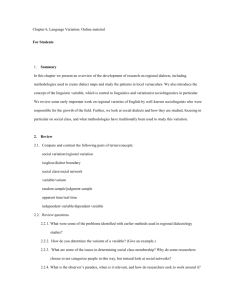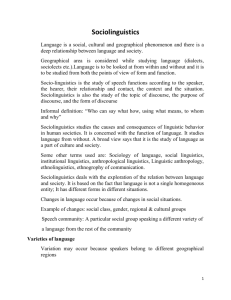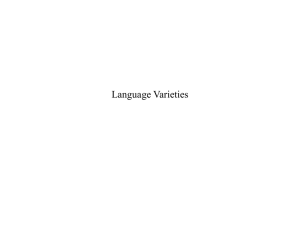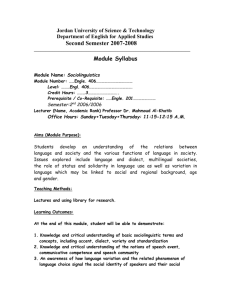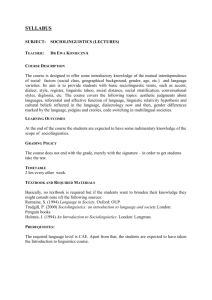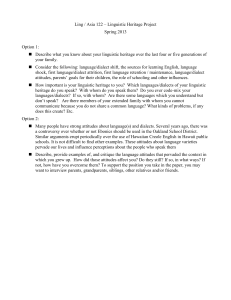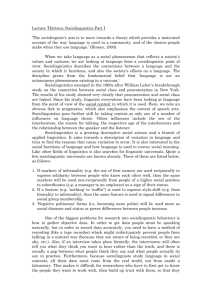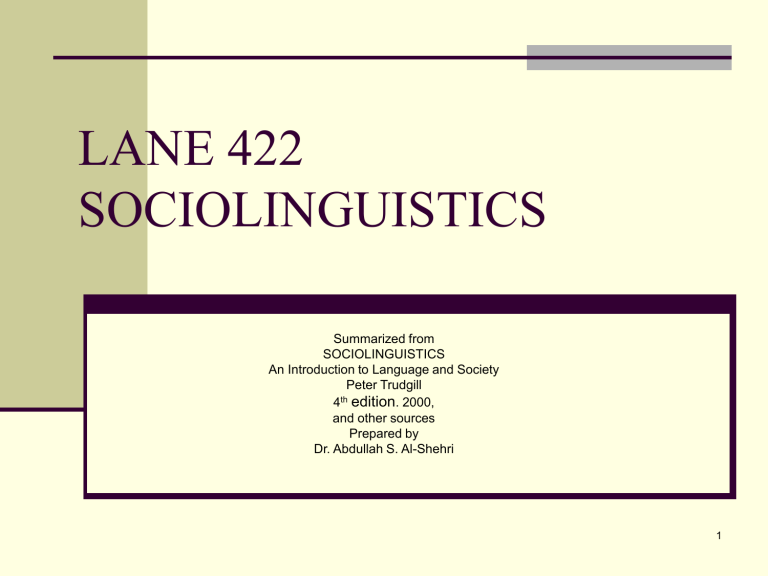
LANE 422 SOCIOLINGUISTICS Summarized from SOCIOLINGUISTICS An Introduction to Language and Society Peter Trudgill th 4 edition. 2000, and other sources Prepared by Dr. Abdullah S. Al-Shehri 1 Chapter 1 Language & Society 2 What is Sociolinguistics? Sociolinguistics is the study of the effect of any and all aspects of society, including cultural norms, expectations, and context, on the way language is used. Sociolinguistics differs from sociology of language in that the focus of sociolinguistics is the effect of the society on the language, while the latter's focus is on the language's effect on the society. Sociolinguistics is historically closely related to Linguistic Anthropology and the distinction between the two fields has even been questioned recently. 3 What is Sociolinguistics? Continued.. Sociolinguistics, then, as the name implies, is ‘the study of language in its social context’. Sociolinguistics is partly theoretical and partly empirical. Sociolinguistics is the part of linguistics which is concerned with language as a social and cultural phenomenon. Sociolinguistics first appeared in the West in the 1960s and was pioneered by William Labov in the US and Basil Bernstein in the UK. William Labov is often regarded as the founder of the study of sociolinguistics. He is especially noted for introducing the quantitative study of language variation and change, making the sociology of language into a scientific discipline. 4 What does sociolinguistics study? Sociolinguistics studies the relationship between language and society. It also studies how language varieties differ between groups separated by certain social variables, e.g., ethnicity, religion, status, gender, level of education, age, etc., As the usage of a language varies from place to place (dialect), language usage varies among social classes, and it is these sociolects that sociolinguistics studies. 5 Why study language in its social context? There is a lot more to understanding language than what the core theoretical areas of linguistics focus upon. If we can gain insight into how language works by studying its formal grammatical properties, we must also realize that language as a "thing" to be studied is necessarily a kind of over simplification, because language isn't a "thing" external to human beings, but rather, something that makes up a part of who we are as human. By studying language in its social context, we learn about language as a social phenomenon. Studying language in its social context, then, helps us learn about ourselves as users of language, and how and why we use language beyond communication purposes (social functions of language). 6 The different social functions of language Primarily, language serves as means for communicating information. People exchange information through the use of language (communicative function). But, that’s not all.. As users of language, we are aware of the other very important social function that is fulfilled by language. That is, language is also used to establish and maintain relationships with other people. Another social function of language is the clue-bearing role that language fulfils. Our use of language can help other people formulate an opinion about us, not so much from what we say, but actually from how we say things. Language thus conveys information about the speakers. 7 Language variation Let’s return for a moment to one of the important social functions of language, that is, its ‘clue-bearing’ role. To know more about each other, people make use of the way language is used by others who come from different regional and social backgrounds. This variation in the regional and social background of a person is often marked by a ‘different variety of language’. Varieties of language are often referred to as ‘dialects’. Language variation, then, is due to two factors: the geographical factor and the social factor. There are thus two types of dialects: geographical (dialects), and social dialects (sociolects). 8 Definitions of: Language, Dialect, Accent, and Idiolect The terms language and dialect are not particularly easy terms to define. “Language” has been defined as “any set or system of symbols used in a more or less uniform fashion by a number of people, who are thus able to communicate intelligibly with one another”. “Dialect” refers to a kind of language, which is distinguishable, to a degree, from other kinds of the same language, in vocabulary, grammar and pronunciation. It is often very important to distinguish between the two terms accent and dialect. The term accent refers to differences in pronunciation only. “Idiolect” is the individual’s unique way of speaking. It contains idiosyncratic characteristics of an individual’s speech. 9 The language/Dialect Continuums In certain cases, neither “dialect” nor “language” represents a clear- cut concept. Some times, there is no clear linguistic breakdown between one dialect or language and another. It is not always possible to state in linguistic terms where people stop speaking one dialect or language and start speaking another. In such cases, we say that there is a geographical dialect or language continuum. A “continuum” is anything that goes through a gradual transition from one condition, to a different condition, without any abrupt changes. No part of a “continuum” can be distinguished from neighboring parts except by arbitrary division.. 10 The German-Dutch Continuum Dutch and German are known to be different or distinct languages spoken in Germany and The Netherlands respectively. However, at some places along the German-Dutch frontier the dialects spoken on either side of the border are extremely similar. If we choose to say that people on one side of the border speak German and those on the other Dutch, our choice is again based on social and political rather than linguistic factors. A close examination of the linguistic situation along the German-Dutch borders will reveal that there is a dialect continuum involving a merger of two languages. 11 The Scandinavian Continuum A more extreme case which illustrates the problematic nature of the two terms (language and dialect) can be taken from Scandinavia. Norwegian, Swedish and Danish are all autonomous, standard languages, corresponding to the three autonomous nations of Norway, Sweden and Denmark respectively. Educated speakers of all three countries can communicate freely with each other, each in his native language. But in spite of this common comprehension (or mutual intelligibility), it would not make sense to say that Norwegian, Swedish and Danish are really the same language. This would constitute a direct contradiction of the political and socio-cultural facts of these countries. 12 The Criterion of Mutual Intelligibility However, if we try to draw dividing lines between such language areas, we would then be basing our division on sociopolitical factors and not linguistic facts. To solve the problem of dialect and language continuums, linguists usually resort to a linguistic criterion known as ‘mutual intelligibility criterion’. That is, if two speakers can understand one another, then they are speaking dialects of the same language. And if they cannot understand each other then they are speaking different languages. This, however, would lead to strange results in the case of German and Dutch, the Scandinavian situation, Mandarin and Cantonese in China, Urdu and Hindi in the Indian Sub-Continent, and in many other places around the world. In such situations, the linguistic criterion of mutual intelligibility as a solution is, however, of no use. 13 The Criterion of Mutual Intelligibility: Not very helpful.. The criterion of ‘mutual intelligibility’, and other purely linguistic criteria, are therefore of less importance in the use of the terms language and dialect than are political and socio-cultural factors. The most important of these factors are autonomy (independence) and heteronomy (dependence). We can say that standard Dutch and German are autonomous, since they are both independent, standardized languages of independent countries. But, the nonstandard dialects of Germany, Austria and German- speaking Switzerland are all heteronomous with respect to standard German. In such cases one would have to go along with the socio-cultural rather than linguistic criteria to interpret the linguistic phenomena in such regions. 14 The Standard The Standard variety is that variety of a language which is usually used in print, and is usually taught in schools and to non-native speakers. It is also the variety which is spoken by educated people and used in news broadcasts and in formal situations. Dialects of any language include standard and non standard varieties. (Standard Arabic is an exception) This is contrary to some peoples’ mistaken believe that the term ‘dialect’ is used only to refer to non standardized varieties of a language. A Standard variety is imposed from above over the range of regional and social dialects, and can thus be called a superposed variety of language, and is the most prestigious of all varieties. 15 The Standard Continued… A standard variety cannot legitimately be considered better than other varieties of the language. This is because the ‘scientific study of language’ has convinced us that all languages, and all dialects, are equally ‘good’ as linguistic systems. All languages and varieties of language are structured, complex, rule-governed systems which are wholly adequate for the needs of their speakers. Value judgments concerning the correctness or purity of linguistic varieties are social rather than linguistic. There is nothing at all inherent in nonstandard varieties that makes them inferior. Any apparent inferiority is due only to their association with speakers from under-privileged, low-status groups, not due to systemic deficiency. Attitudes towards nonstandard dialects are attitudes which reflect the social structure of society. 16 Why isn’t Standard Arabic a dialect? In order for a variety of language to be called a dialect it would have to be used as a native spoken variety of a group of people. Standard Arabic is not! Arabic language is diglossic, which means there are two levels of the language: high (classical / standard / written / formal) and low (spoken / vernacular / informal). 17 What is Standard English (SE)? SE is a dialect of English. SE is the variety of English which is used in print, and which is usually taught in schools and to non-native speakers. SE is the variety spoken by educated people and used in the media. SE developed out of the English dialects/varieties used in and around London. These dialects were modified through the centuries by speakers at the court, by scholars and writers, and later by so-called Public Schools. The resulting variety became the dialect used by upper society members in London. 18 SE Continued.. SE became too different from the varieties used by other social groups. With the invention of printing, this variety began to be used in books. Today, we can find SE regional differences: American SE, Scottish SE, Australian SE, English SE, etc There is no universally acknowledged standard accent for SE. There is no necessary connection between SE and any particular accent, however, RP is usually associated with SE. SE can be spoken with any regional accent, and it mostly is. SE is not linguistically better than any other variety of English. 19 Standard vs. Nonstandard Varieties All languages and dialects are equally good as linguistic systems. All dialects of language are rule-governed systems. Value judgments concerning correctness and purity of dialects are social and not linguistic. There is nothing inherent in non-standard dialects that make them inferior. Any apparent inferiority is due only to their association with under- privileged groups. 20



